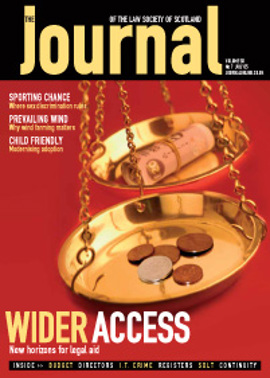Adopting a new approach

The long-awaited report of the Adoption Policy Review Group, chaired by Sheriff Principal Cox, was presented to the Scottish Executive on 6 June 2005. It is to be hoped that its recommendations will be accepted and that legislation will speedily follow, for the report is based on (i) a careful examination of the existing law, (ii) a realistic appraisal of how adoption operates in Scotland today, and (iii) an absolute commitment to keep the child’s interests at the centre of everyone’s attention. The recommendations are likely to be debated in detail by both the press and our elected representatives, and many elements are likely to change before legislation is eventually presented to the Parliament. But it is useful now to be aware of the proposals and the context in which they are made, in order that reactions to that debate (at least from the legal profession) can be informed and focused.
Increasing the number of adopters
The headline-grabbing recommendation, presented by most of the press as if this report dealt with nothing else, is the recommendation that unmarried couples, both opposite-sex and same-sex, be permitted to adopt (as in England and Wales under the Adoption and Children Act 2002, which comes into effect at the end of 2005). The whole debate on the adoption changes runs the serious risk of being hijacked by those opposed to conferring any legal recognition to unmarried couples, particularly same-sex couples. This issue ought to have been addressed (as I advised, to deaf ears) while the Civil Partnership Act 2004 was going through Parliament: it is an adults’ issue on morality, the common good and how society should develop rather than a children’s issue on what is best for any individual child. The rest of this article will address the children’s issues that make up the vast bulk of the (bulky) Cox Report.
Where security meets flexibility
Adoption today is an all or nothing concept: it creates a new parent-child relationship through the destruction for virtually all purposes of the original parent-child relationship. It was not always thus, and adoption as introduced into Scotland in 1930 was little more than a sort of protected fostering, whereby the adoptive “parents” were given obligations of “custody, maintenance, and education”. Adopters and adoptees were brought within the forbidden degrees in the 1950s; succession rights came in the 1960s; and it was not until the Adoption (Scotland) Act 1978 (coming into force in 1985) that the complete legal divorce of birth parents from adoptees was achieved.
It has long been accepted that children need above all else security, a sense of belonging, a sense of knowing that they are settled where they are and cannot be removed. It has since 1985 been assumed that this is achieved by a “clean break” that is complete for virtually all purposes. However, that assumption has never been fully justified for older children who already have established relationships with a whole family network and who have been compulsorily removed from their parents through childcare procedures.
Such children tend to be much more disparate and have a wider variety of difficulties and needs than young babies. In response to this reality the Cox Report recommends the introduction of a wholly new order that will act as an alternative to adoption and be much more flexible in meeting the needs of individual children. “Permanence orders” would allow parental responsibilities and parental rights to be shared with local authorities, carers and, if appropriate, birth parents. Children subject to these orders would be looked-after children and only local authorities would be able to seek such orders. There would be no effect on succession rights or forbidden degrees. They would be flexible enough to take account of the different needs of different children, and permit varying degrees of contact and maintained relationships with birth families. The order would be designed to provide the child with security, but without the complete destruction (in law) of existing family relationships.
The Cox Report is at pains to emphasise that it is not recommending the introduction of the European dual model of “simple adoption” as an alternative to “full adoption”. This might be no more than a matter of terminology, for the effect of a permanence order will be much the same as the effect of a “simple adoption”. But terminology is important as it affects people’s reactions to legal processes, and for that reason the report has, in my view, adopted a sensible approach. It is easier for a birth parent to accept that his or her child has been permanently removed than to accept the legal fiction that he or she is no longer a parent. In many ways, the recommendation is that Scots adoption law returns to its 1930 roots. More accurately, perhaps, and elaborating the horticultural metaphor, the 1930s roots have thrown up a new sucker as an alternative to the main plant which is, on close inspection, a mere graft.
Dispensing with parental consent
The existing two grounds for dispensing with parental consent to adoption have generated a substantial amount of case law. The Cox Report recommends that these grounds be amended, for three reasons: to simplify them, to make them consistent with English law (where the grounds were simplified in the 2002 Act), and to meet more readily the requirements of article 8 of the ECHR. English adoption law provides only two grounds for dispensing with consent: (i) that the parent or guardian cannot be found or is incapable of giving consent, and (ii) that the child’s welfare requires the consent to be dispensed with.
The breadth of the second ground has some dangers; it justifies moderating that ground with ECHR principles. It would not be sufficient that the prospective adopters could offer to give the child a better life than the birth parents: in addition, the interference in family life that adoption undoubtedly is must be in accordance with the law and necessary to protect the health or the rights and freedoms of others. In other words, dispensing with consent must be a proportionate balance between competing but legitimate interests. The report does not attempt to draft new grounds based on the English model as moderated by article 8, but this should not prove difficult to do.
Title and section 11 orders
The Children (Scotland) Act 1995 amended adoption law to ensure that a person whose parental responsibilities and parental rights are removed by an adoption order cannot seek the restoration of any of these responsibilities and rights by means of a section 11 order under the 1995 Act (section 11(3) and (4)). The Cox Report recommends the abolition of this rule and its replacement with a rule that a previous parent can seek a section 11 order but only with the leave of the court. Court leave is not common as a process in Scotland, but it is not unknown (for example in relation to revocation of freeing orders: section 20 of the 1978 Act). In my view this is a sensible compromise between the child’s need for security and the rights of the birth parent. It always was anomalous that the birth parent is the only person in the world who cannot seek, for example, a contact order in respect of a child, and in any case the rule relates only to title and the court is perfectly free to award contact to a birth parent if sought by another person (for example the child).
To revoke or not to revoke?
The present law is strongly resistant to the notion that an adoption order once made can be revoked: this has led to some dubious results (of which Cameron v MacIntyre’s Executor 2004 SLT 79, in which an adoption order made on the adoptee’s 21st birthday could not be revoked over 50 years later is the most recent example). Legislation elsewhere, such as in Australia and New Zealand, permits the discharge of adoption orders for reasons such as duress, fraud or material mistake, and the Cox Report examines whether it would be sensible to follow this approach. It recommends not, even in exceptional circumstances of fraud or grave irregularity: this in order to underpin the security and stability that adoption is intended to provide. I am not convinced that this argument answers the concerns of those who would prefer revocability in cases of irregularity and gross unfairness.
Full consideration needed
The report also contains a large number of detailed procedural recommendations, including the abolition of the little-used interim adoption orders. The recommendations are primarily designed to speed the process, ensure a more robust appeal mechanism, enhance the training and role of curators ad litem, reporting officers and safeguarders, free the fostering system from unnecessary limitations and ensure that fair and appropriate regulations are in place in respect of access to information.
This is a far more wide-ranging and detailed report than the press have indicated (or even than can be described here). It needs to be read and digested in full, and it is pointless and misrepresentative and bad for children not to do so.
Kenneth McK Norrie, University of Strathclyde
In this issue
- Commissioner: Public Authorities must do more
- Supporting legal aid
- No country cousins
- Making the money go further
- Adopting a new approach
- Gordon giveth and Gordon taketh away
- A blow for the future
- A Wie hint of change?
- Raising the bar
- The IT crimewave
- The directing mind
- Going through the motions
- Planning in the park
- Always look on the bright side
- Scottish Solicitors' Discipline Tribunal
- Website reviews
- Book reviews
- The race to the registers revisited
- SDLT: getting it right
- SDLT: barcoding
- Business sense






